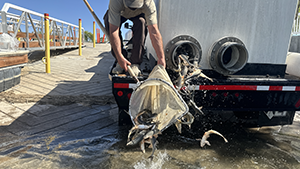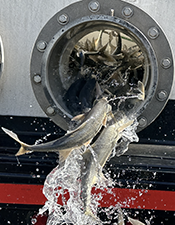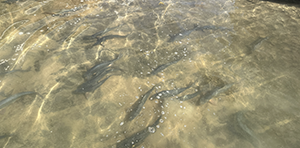 U.S. Fish and Wildlife Service employee Ty Terry releases endangered bonytails into Laughlin Lagoon after they made an 11-hour trip from New Mexico.
U.S. Fish and Wildlife Service employee Ty Terry releases endangered bonytails into Laughlin Lagoon after they made an 11-hour trip from New Mexico.
Late this spring, more than 2,400 endangered fish made a 700-mile journey that ended in a lagoon off the Colorado River in Laughlin, Nevada. It only took them 11 hours.
Instead of navigating rapids and avoiding predators, these rare bonytail made the trip in the temperature-controlled comfort of a U.S. Fish and Wildlife Service tanker truck.
They were the year’s final stocking for the Lower Colorado River Multi-Species Conservation Program, a partnership of 57 entities throughout Arizona, California and Nevada administered by the Bureau of Reclamation.

“Bonytail are federally listed as endangered under the Endangered Species Act,” explained Fisheries Group Manager Jim Stolberg. “They are considered functionally extinct from their historical range, and their existence in the Colorado River Basin now relies entirely on stocking.”
Bonytail, which are believed to have evolved between 3- and 5-million years ago, are the rarest native fish in the Colorado River. Their numbers have declined due to changes in habitat and competition from non-native species.
The program’s native fish stocking effort, which also includes razorback suckers, generally occurs between November and May.
In addition to the recent group, 4,331 bonytail were released into the Colorado River at Laughlin Lagoon, Moabi Regional Park south of Needles, California, and in a backwater near Blythe, California, during this year’s stocking season according to Stolberg. The goal is to release 620,000 bonytail during the program’s 50-year life. Since 2005, the program has stocked more than 141,400.
The bonytail were spawned from broodstock at the Southwestern Native Aquatic Resources and Recovery Center in Dexter, New Mexico. The Center maintains the only bonytail broodstock used for species propagation in the world. The parents of these fish came from Lake Mohave, which is a few miles north of Laughlin Lagoon on the upstream side of Davis Dam.

“Fish must be larger than 12 inches and have a passive integrated transponder tag injected before they can be released,” Stolberg explained. “Most will spend two to three years at the center before they meet those requirements.”
The transponder triggers a reading each time a fish passes close enough to one of the many readers the program has installed throughout the lower basin. Stolberg said this allows the program to track individual fish.
This year, the program also released 13,554 razorback suckers during 10 stocking events.
“We've seen an encouraging response to our razorback sucker augmentation/stocking efforts over the last few years,” said Stolberg. “Razorback sucker population estimates in Lake Mohave, and lower reaches of the river are the highest they've been since our fish augmentation began in 2005.”
To learn more about the program’s fish augmentation efforts, visit www.lcrmscp.gov/activities/fisheries.

